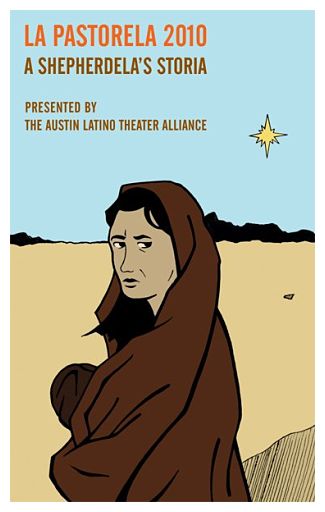Review: La Pastorela 2010 - A Shepherdla's Story by ALTA Teatro
by Michael Meigs
La Pastorela, the tale of the shepherds on their way to Bethlehem in search of the promised newborn babe, has a lot of history behind it. That Bible story came to the New World with the Spanish troops and frailes who occupied the New World, of course, and while accepting that account, the indigenous peoples interpreted in terms of their own experience. La Pastorela tells the story of Gila, the shepherdess who receives a visitation by the Archangel Gabriel, with the mission of persuading her family of pastoral people to travel to witness the promise of new birth and salvation. The zip and the zest of the spectacle comes from the arrogance and determination of Luzbel the beefy devil and his forces as they try to stop the shepherds' progress.
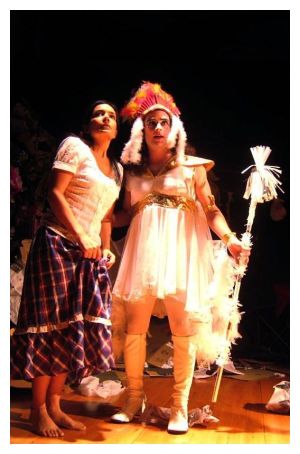
This Christmas enactment has as strong a place in Mexican and Tejano culture as does the Santa Claus tradition for the Anglos, and it makes for a much more exciting story. We take it for granted that Santa will clock in on time every Christmas Eve, but the humble human striving of this band of rural folk faces really fearsome opposition.
Austin's Tejano community began staging La Pastorela back in 1997 in a City of Austin warehouse that stood at the current site of the Emma S. Barrientos Mexican-American Cultural Center. It was a cooperative effort from the very first. The pride of the community and their attachment to this celebration are evident in the meticulous two-page chronicle of the evolutions of the play over the years since that time.
The first script was a compendium, drawn from ten other versions. Directors, versions and approaches have changed, and the relatively informal Austin Latino Theatre Alliance has evolved the tradition of using a different director every year. As in much popular theatre and street theatre, the texts have frequently referred to contemporary issues and events, integrating them into the action. For example, director Patricio Villarreal Ávila's text for this year's version has one of the campesinas make a couple of tart observations about Arizona, and the hermit traditionally featured in the story is a homeless woman.
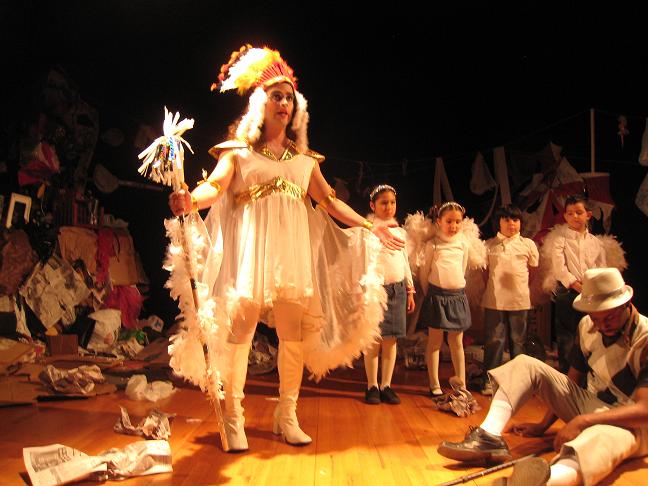
It's a lot of fun and comfortably bilingual. The play is presented in the relatively intimate setting of the black-box theatre in the south wing of the MACC, not in the more spacious auditorium on the north side, where a capoeira class was practicing that graceful Brazilian martial art.
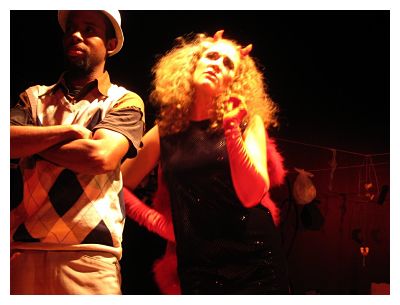 As the opening night audience of 50 or so gathered in the breezeway, a diminutive, strutting man in Indian head dress, flowing white gown and astonishing white boots came out with a handful of "angelitos" to take care of crowd control. With the decisiveness and direction of a drill sergeant, Tony Salinas formed us into a line and brought us forward ten-by-ten for brief individual interrogatories ("Are you the devil?" "No!" "Then, pass!") and an examination of our "documents" (i.e., the ticket!) before we moved into the theatre.
As the opening night audience of 50 or so gathered in the breezeway, a diminutive, strutting man in Indian head dress, flowing white gown and astonishing white boots came out with a handful of "angelitos" to take care of crowd control. With the decisiveness and direction of a drill sergeant, Tony Salinas formed us into a line and brought us forward ten-by-ten for brief individual interrogatories ("Are you the devil?" "No!" "Then, pass!") and an examination of our "documents" (i.e., the ticket!) before we moved into the theatre.
The acting area was covered with trash, as if it were a hobo jungle somewhere down along the Colorado. Musicians led by Francisco 'Kiko" Villamizar played guitar, percussion and accordian, establishing a lively tipicorhythm as the action began. Salinas turned out to be San Miguel -- the archangel Michael -- in person, delivering his message to Ana Luisa Esperón as Gila the pastorela. She summoned forth her father, family and friends from their refuges in the trash and delivered the message, which much perplexed them. Some thought that she had flipped; others decided to trust her message.
Everything's up close and personal in that black box theatre, so don't be alarmed if someone gets up out of the audience or slamming in through one of the emergency exits. Privately, San Miguel instructs dapper demi-angel Cucharón ("Big Spoon," played by Christopher Edwards) to ingratiate himself with the shepherds and to watch over them.
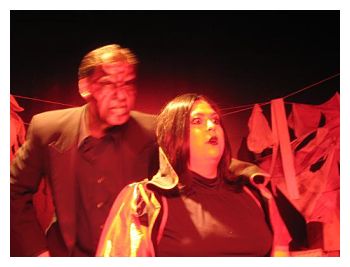
A squared-off man in dark glasses surges up on to the stage, disgusted with the proceedings, and we quickly understand that Frank Barajas is Luzbel (Beelzebub), scornful of God and of all these pansy doings. Barajas has a powerful presence, and his malificence is further emphasized in Act II when he comes stalking from the back, down the center aisle, with some really scarey facial makeup in red and black. His sidekick Pecado ("Sin" - Laura Freeman) is an attractive slim she-devil with a hell of a singing voice.
There's an improvisational looseness in the action that's very appealing, and the characters frequently use song. The grown-ups are accompanied by a half-dozen or so young persons of about 5-7 years of age, dressed as "angelitos" or "pecadillos" ("little sins"), as appropriate.
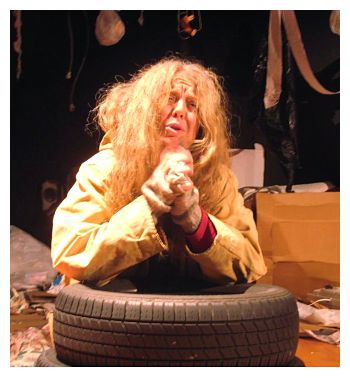
The traveling band of shepherds is augmented not only by Cucharón but also by Andrea Carlisle as Ermitaña (the hermit woman) in the guise of the semi-deranged homeless woman and by the mysterious Astucia (Karla Longnion), a recent conquest of the devil.
Many a trick is played on the shepherds, They are in danger of losing heart, blaming Gila for their plight. Luzbel and his supporters appear in force, threatening to overwhelm them and the world, but the calm, self-certain San Miguel materiaizes and engages them. The devilish forces are almost frantic in triumph, while San Miguel is as serene and cool as a banana split.

The strident conflicts among all these forces are suddenly stilled by the announcement that the Child has been born. A woman in peasant dress walks down the aisle and stands silent, facing the shepherds and with her back to the audience, holding a small, very real baby to her shoulder.
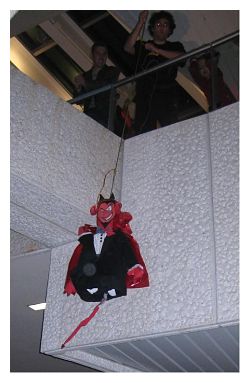 It's a beautiful, very long pause, as both the characters and we seek to understand the mystery that has been presented to us.
It's a beautiful, very long pause, as both the characters and we seek to understand the mystery that has been presented to us.
Because La Pastorela is more a mutual celebration than a formal stage event, the cast doesn't bother with a curtain call. Instead, San Miguel with his self-assurance commands us forth to the plaza, where to the children's delight they find a devil-shaped piñata awaiting, suspended from the balcony.
San Miguel chooses those who are permitted to take a swing at Luzbel (and I was honored and delighted to be authorized a couple of Christmas whacks at Old Nick). Once he has gotten enough battering, the accomplices upstairs happily shower down candies for the crowd below.
EXTRA
Click to view the program for La Pastorela by the Austin Latino Theatre Alliance
La Pastorela 2010 - A Shepherdla's Story
by Patricio Villarreal Ávila
ALTA Teatro
